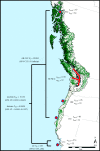Genetic analyses of historic and modern marbled murrelets suggest decoupling of migration and gene flow after habitat fragmentation
- PMID: 19906669
- PMCID: PMC2842750
- DOI: 10.1098/rspb.2009.1666
Genetic analyses of historic and modern marbled murrelets suggest decoupling of migration and gene flow after habitat fragmentation
Abstract
The dispersal of individuals among fragmented populations is generally thought to prevent genetic and demographic isolation, and ultimately reduce extinction risk. In this study, we show that a century of reduction in coastal old-growth forests, as well as a number of other environmental factors, has probably resulted in the genetic divergence of marbled murrelets (Brachyramphus marmoratus) in central California, despite the fact that 7 per cent of modern-sampled murrelets in this population were classified as migrants using genetic assignment tests. Genetic differentiation appears to persist because individuals dispersing from northern populations contributed relatively few young to the central California population, as indicated by the fact that migrants were much less likely to be members of parent-offspring pairs than residents (10.5% versus 45.4%). Moreover, a recent 1.4 per cent annual increase in the proportion of migrants in central California, without appreciable reproduction, may have masked an underlying decline in the resident population without resulting in demographic rescue. Our results emphasize the need to understand the behaviour of migrants and the extent to which they contribute offspring in order to determine whether dispersal results in gene flow and prevents declines in resident populations.
Figures




References
-
- Allendorf F. W., Luikart G.2007Conservation and the genetics of populations Malden, MA: Blackwell Publishing
-
- Becker B. H., Beissinger S. R.2006Centennial decline in the trophic level of an endangered seabird after fisheries decline. Conserv. Biol. 20, 470–479 (doi:10.1111/j.1523-1739.2006.00379.x) - DOI - PubMed
-
- Becker B. H., Beissinger S. R., Carter H. R.1997At-sea density monitoring of marbled murrelets in central California: methodological considerations. Condor 99, 743–755 (doi:10.2307/1370485) - DOI
-
- Beissinger S. R., Peery M. Z.2007Reconstructing the historic demography of an endangered seabird. Ecology 88, 296–305 (doi:10.1890/06-0869) - DOI - PubMed
-
- Brown J. H., Kodric-Brown A.1977Turnover rates in insular biogeography: effect of immigration and extinction. Ecology 58, 445–449 (doi:10.2307/1935620) - DOI
Publication types
MeSH terms
LinkOut - more resources
Full Text Sources

